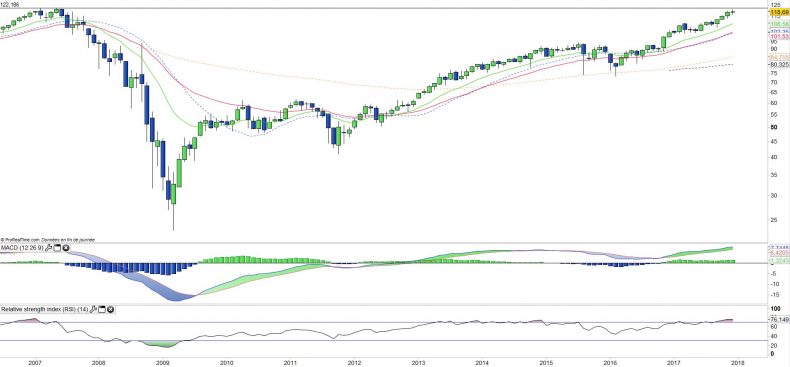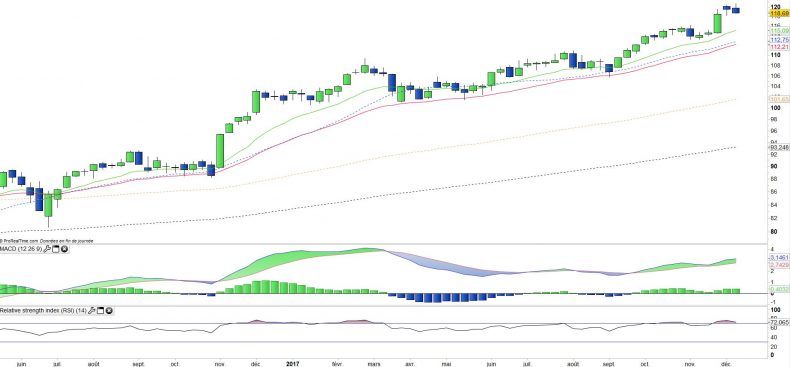iShares ETF US Financials - IYF - 15/12/2017
Short Term strategy : Positive (100%) / Trend +
Long Term strategy : Positive (100%) / Trend +
Characteristics of the ETF
The IYF ETF (iShares) created in 05/2000 and listed on the Nyse, reproduces an index based on a selection of 290 US financial stocks. The tracked index is the Dow Jones U.S. Financials Index. This is a very specialized index from a geographical point of view, composed mainly of US stocks and quoted in USD.
The fee for this ETF is 0.44% and the AUM is approximately $ 2034m. The replication method is direct and there is a dividend distribution policy.
Alternative ETFs: XLF (SPDR, in USD), VFH (Vanguard in USD), FNCL (Fidelity in USD)
Index & components
IYT reproduces an index composed of banks, insurance companies and companies specializing in banking transactions. The top 10 holdings account for about 40% of the index and are among the world's largest financial companies, such as Warren Buffet's Berkshire Hathaway, as well as the prestigious JP Morgan, Goldman Sachs and Citibank banks. but also companies like Visa and Mastercard specialized in bank cards. So it's a very deep index, diversified from a business point of view, but with a US origin even though some of these companies have global operations, so it's basically a dollar exposure.
We believe that this ETF is interesting because of the quality of the companies that make it up, its depth and the diversification offered within the financial universe that goes well beyond a banking index. Since its creation in May 2000, the IYF ETF has achieved a cumulative performance of 4.6%, which is not negligible if we take into account that this sector went through the financial crisis of 2007-2008, the most significant since the Great Depression of 1929. There is some volatility inherent in the financial companies that has not abated since the end of the subprime crisis.
Financial companies are companies that are very sensitive to macroeconomics, they are specific cyclicals whose profits vary according to the interest rate curve, the economic situation which conditions the rise of risks and, of course, the behavior of investors and financial markets. Because of their importance in the economic system, financial companies are subject to more or less strict regulations depending on the period, which also affects the return on equity. Financials are volatile and operate from a global point of view, which means that they are potentially sensitive to a particular problem in a given region (bankruptcy of a country, a hedge fund, monetary or political crisis). US financials currently benefit from a promise of deregulation that would be very favorable to banking activities and the rise in markets that has a positive impact on trading activities.
Large US banks are now allowed to increase dividends or buy back shares, while the administration plans to relax the rules put in place from 2010 to better regulate banks and avoid risk taking excessive. A positive news feed (at least in the short term) for the sector.
Latest developments
IYF's performance has been 17.6% since the beginning of the year, slightly lower than the S & P500 (+ 18.9%), after a rise of 14.8% in 2016.
The banking sector should be one of the sectors who should benefit the most from D.Trump's fiscal plan, which aims to lower corporate taxes from 35% to around 20% while Republican leaders of the Senate and House of Representatives apparently reached an agreement on the tax reform, which would represent the biggest overhaul of the US tax system since 1986.
Despite the gradual rise in short rates triggered by the FED, which should continue at a rate of 3 new increases of 25 basis points in 2018, long-term rates remain at c.2.35%, which is explained by the absence of inflation, despite excellent job creation statistics. This flattening rate curve is not favorable to banks. The productivity gains made possible by ever more digitization and automation as well as a low oil price and an open economy that puts global wages in competition are certainly explanatory factors.
Monthly data
The monthly chart shows a bullish trend that is accelerating sharply but coming up on a significant resistance, consisting of the 2007 summit just before the financial crisis. The oscillators are fully overbought which makes the crossing of the resistance quite unlikely in the short term. A pause, at least is expected on these levels, but a correction would not be a surprise.
Weekly data
On the weekly chart, we can see a bullish trend also very strong, composed of oscillations that finally recorded minimal corrections (on the EMA26) since the election of D.Trump in November 2016 which increases all the more the need for correction on the index. The MACD, however, seems to still have some upward margin and no correction signal has been launched yet, so the trend can continue for a while.
ETF Objective
IYF is an ETF in $ which seeks to replicate an index composed of 290 U.S. equities in the financial sector (Banks, Real Estate, Insurance, Software Services)
Characteristics
| Inception date | 22/05/2000 |
| Expense ratio | 0,44% |
| Issuer | iShares |
| Benchmark | DJ US Financials index |
| ticker | IYF |
| ISIN | US4642877884 |
| Currency | $ |
| Exchange | NYSE |
| Assets Under Management | 2 034 M$ |
| Dividend | distribution |
| Currency risk | No |
| Number of Holdings | 290 |
| Global Risk | 4/5 |
Country Breakdown
| USA | 100% |
Sector Breakdown
| Banks | 33% |
| Diversified Financials | 27% |
| Real Estate | 19% |
| Insurance | 14% |
| Software & Services | 7% |
Top Ten Holdings
| Berkshire Hathaway | 7% |
| JP Morgan Chase & Co | 7% |
| Wells Fargo | 5% |
| Bank of America | 5% |
| Citigroup | 4% |
| Visa Inc | 4% |
| Mastercard Inc | 3% |
| Goldman Sachs | 2% |
| US Bancorp | 2% |
| Morgan Stanley | 1% |


